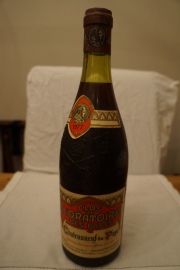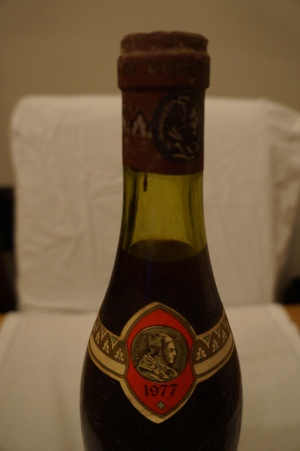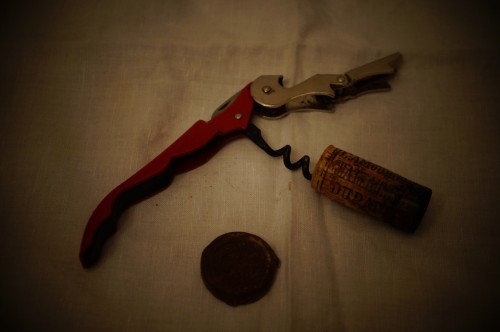 First off, I apologise for the delay between posts. When I started this blog, I was working a shorter week and was kindly allowed a couple of hours ‘blogging time’ on my day off by a pair of obliging napping babies…those days have passed, but as promised here is my follow on from my last post [part 1].
First off, I apologise for the delay between posts. When I started this blog, I was working a shorter week and was kindly allowed a couple of hours ‘blogging time’ on my day off by a pair of obliging napping babies…those days have passed, but as promised here is my follow on from my last post [part 1].
To recap, I had won a wine auction consisting of 2 St. Emilion Bordeaux, 2 left-bank Bordeaux and a Chateauneuf-du-Pape (Southern Rhone) – all from the 1970’s and all a little fusty looking. Figuring that all of them would, at the very least, be better drunk 20 years ago ready to drink, I wasted little time in opening the first bottle of my winnings.
I started with the Clos de L’Oratoire des Papes, Chateauneuf-du-Pape, 1977 on a random Tuesday night in March. I chose this one to start as it was the murkiest and thought I’d start with the one least likely to thrill (considering the Tuesday thing). Secondly, it’s from my birth year and thirdly, I LOVE the label.
Incidently, Chateauneuf du Pape is perhaps the greatest appellation in the Southern Rhone (mid, southern France), consisting of a Grenache, Syrah blend with perhaps a splash of (most commonly) Mourdevre and Cinsault. The wines are generally powerful, big and fruity…oh, and red.
I thought that a good way for me to describe what the wine was like and how I came to my conclusion would be to demonstrate with a little tasting lesson (I’ve tried to keep this as brief as possible, apologies for the ramblings), so here is my method;
1) Examine the condition of the bottle – promising (despite that I can see the wine inside is cloudy)
I note that the bottle has lost about 3cm of wine from the neck of the bottle. This will be due to evaporation through the cork – not bad I suppose for 35 years of storage. The bottle is dusty but the label is in good nick and there are signs of mould round the cork suggesting some dampness in the atmosphere where it’s been stored – none of these are indicative of quality but I’m clutching at my ‘Lord of the Manor’ theory that the bottle has been cellared for most of its aged life and not in someone’s garden shed under the LHR flight path.
2) Google – less promising
I should’ve done this in the first place with the little information that I did have in the auction listing. I search the name of the wine and include the vintage hoping to find it selling at Sotheby’s for £600 a bottle – alas, I find nothing. I do find however that this particular wine is still being produced under the same label (reading between the lines, by a different wine maker) and the 2008 Clos de L’Oratoire vintage is being sold by Sainsbury’s for £18.99 . This is quite exciting and I have made a mental note to try this at a later date once my purse has recovered from the auction, plus it suggests that the wine could’ve once been a decent drop. The current recommendation is to drink it within 15 years, so I’d say that my 1977 is too long in the tooth by about 25 years.
I also google ‘vintage reports Rhone 1977’ and this is what I get back from Decanter Magazine: “Rating – 1 out of 5 stars.” “Style – Pallid and astringent from the north, and modest wines from southern Rhone, not for keeping.” “Weather Conditions – The year showed promise, despite an unusually cool summer, and a dry warm September helped the grapes to ripen in the south. But then rain ruined those prospects.”
Groan.
3) Open the wine – better
I feel really naughty opening this, despite my previous observations. Incredibly, the cork came out whole and looking at its stain, I’m guessing that the bottle has at least been stored on its side.
4) Decant – (as my youngest would say) oh oh
Decanting allows the air to mix with the wine and the flavours develop. It also allows the wine to be filtered, a good idea in the case of an old wine like this and the manky debris at the bottom of the bottle can be left just there. I am hit with rather a pronounced, and sadly ‘off’ nose even at arms length. I start to convince myself that it isn’t cloudy after all.
3) Pour and observe. – not looking good
Wine tasting is best done from a glass with a small rim circumference to keep the aromas in the glass. Ideally, you should be able to hold the glass up to a white background to observe the colour (hue, how it fades/ differs towards the rim), clarity and intensity. In this case, the wine is brown in colour – red wines tend to fade with age from purple to red to brown, so this is expected for a wine this age. However, the wine is also cloudy, tainting the colour to become sludgey, not the crisp, fresh brown of a sherry for example. The wine appears to be very lightweight (as opposed to a younger Chateauneuf which I would expect to be a deep or even opaque intensity) and when I swirl it around and watch how the wine runs back down the sides of the glass, it appears remarkably legless. Chunky legs mean more body and hence more alcohol.
Conclusion so far; faulty, lifeless, limp, little to no alcohol.
4) Smell (or ‘nose’) – game over
Since I first opened the bottle, the nose has been rather overwhelming with strong dusty aromas of almonds, marzipan and rubber, all together a tell tale sign of oxidation and in this case, not in a good way (some wine production purposefully allows oxygen into the wine to give this taste i.e. Oloroso sherry). Ordinarily, to check the nose of a wine, firstly, swirl the wine around the glass, increasing the amount of oxygen mixing with the wine (same effect as letting a wine breathe) which opens up the nose making it easier to identify the aromas. Once it’s swirling, stick your nose into the glass and take a big sniff – not too big in this case as I can smell it from my keyboard. Think about how strong the nose is – you can generally expect red wines to have less of an aroma (less pronounced) than white. Have a think about what you can smell? With ‘normal’ wine, you should be getting fruit or floral notes, herbs perhaps, earthy tones, sweetness. Anything goes really, think about what associations it gives you – just remember, you can never be wrong.
 5) Taste (finally – bear with me) – do I have to?
5) Taste (finally – bear with me) – do I have to?
To be honest, I really didn’t want to, but knowing it would do no harm, I did and it actually didn’t taste as bad as I thought. Disappointingly, there was very little to it; On top of the wine being fully oxidised, all the body had gone and there wasn’t a suggestion of any fruit. The only positive thing I can say is that there was some tannin still, but sadly only in the way that Original Listerine has tannin. Needless to say, I didn’t drink any more beyond this initial taste.
To finish my tasting lesson, if you can now imagine that you’re tasting a 2008 Chateauneuf, , take a sip, enough to cover the tongue generously. Make a little ‘o’ shape with your lips and breathing in through your mouth and without breathing in the wine, ‘slurp’ the wine in your mouth, letting the air through the wine to open up the flavours and really get the wine everywhere in your mouth to reach all of your taste buds. Once you’ve tasted it properly, swallow or spit (personal preference/ circumstance, arf arf), definitely the former in the 2008 case, the latter in the 1977 case.
Then have a little ponder and ask yourself whether you liked it (most important), what could you taste, does it remind you of anything? Can you pick up a particular fruit or herb perhaps? Is it creamy (dairy and vanilla flavours indicate oak)? How acidic or tannic is the wine? You’ll feel tannin in your gums in red wine only (if you feel like your teeth have been stripped and your gums dried out , take it that the wine is very tannic). Likely in the case of a decent Ch-du-P, you’ll be tasting a smooth and spicy cherry or blackcurrant concoction.
Although there is little that makes me smugger than when my own tasting notes match those of the wine producer, don’t be intimidated by worrying about getting it right, agreeing with anyone else or being pretentious. To get to Oz Clarke levels of clever wine descriptions takes some practice. As you get used to different wines, you get used to what to look out for. Use your imagination – if you taste chocolate or coffee or it brings back images of bonfires and candyfloss, that’s how it tastes to you – there’s no right or wrong. The important thing is whether the wine is not faulty (i.e. not corked or oxidised – yes, there’s a difference) and whether you might enjoy drinking a whole glass. In the case of the 1977, no thanks siree!
6) Conclusion – past it.
Damn it. After tasting 1 of 5 of my auction treasures, I’m seriously hoping that I started with the worst – if they’re all like this, this literally was £75 tipped down the kitchen sink. Still, no regrets as it’s not every Tuesday one gets to try a wine relic from one’s birth year, so I’m still left feeling pretty special (if I ever manage to rid myself of the lingering smell that has ingrained itself into my brain) and rather extravagant.
And… congratulations for reading to the end!



Shame! But at least you salvaged an entertaining lesson. Consider me schooled :O)
I had a similar experience with a 1977 German Riesling…it’s also my birth year so I was excited to try it but the winemaker had already warned me that it was probably over. Made for one of the most hilarious photos of my wife and I trying it. Her – disgusted – face is priceless…
Ha! I hear her! If only I was 25 and this might not have been a problem 🙂
She is, so…we get to try the 87s, which are still remarkably fresh.